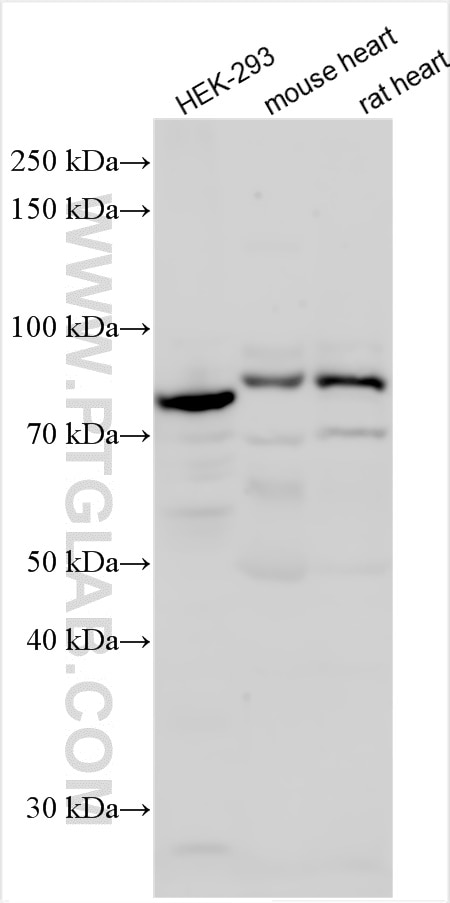Tested Applications
| Positive WB detected in | HEK-293 cells, mouse heart tissue, rat heart tissue |
Recommended dilution
| Application | Dilution |
|---|---|
| Western Blot (WB) | WB : 1:500-1:3000 |
| It is recommended that this reagent should be titrated in each testing system to obtain optimal results. | |
| Sample-dependent, Check data in validation data gallery. | |
Product Information
25409-1-AP targets GAS2L3 in WB, ELISA applications and shows reactivity with human, mouse, rat samples.
| Tested Reactivity | human, mouse, rat |
| Host / Isotype | Rabbit / IgG |
| Class | Polyclonal |
| Type | Antibody |
| Immunogen | GAS2L3 fusion protein Ag22097 Predict reactive species |
| Full Name | growth arrest-specific 2 like 3 |
| Calculated Molecular Weight | 694 aa, 75 kDa |
| Observed Molecular Weight | 75 kDa |
| GenBank Accession Number | BC043366 |
| Gene Symbol | GAS2L3 |
| Gene ID (NCBI) | 283431 |
| RRID | AB_3669473 |
| Conjugate | Unconjugated |
| Form | Liquid |
| Purification Method | Antigen affinity purification |
| UNIPROT ID | Q86XJ1 |
| Storage Buffer | PBS with 0.02% sodium azide and 50% glycerol , pH 7.3 |
| Storage Conditions | Store at -20°C. Stable for one year after shipment. Aliquoting is unnecessary for -20oC storage. 20ul sizes contain 0.1% BSA. |
Background Information
GAS2L3 also known as G2L3, belongs to the GAS2 family of four related proteins. It contains an N-terminal calponin homology (CH) domain and a C-terminal GAS2-related (GAR) domain, which are putative actin and microtubule binding domains. GAS2L3 is specifically expressed in mitosis and it localizes to the midbody and the constriction zone during cytokinesis (PMID: 28937871).
Protocols
| Product Specific Protocols | |
|---|---|
| WB protocol for GAS2L3 antibody 25409-1-AP | Download protocol |
| Standard Protocols | |
|---|---|
| Click here to view our Standard Protocols |



